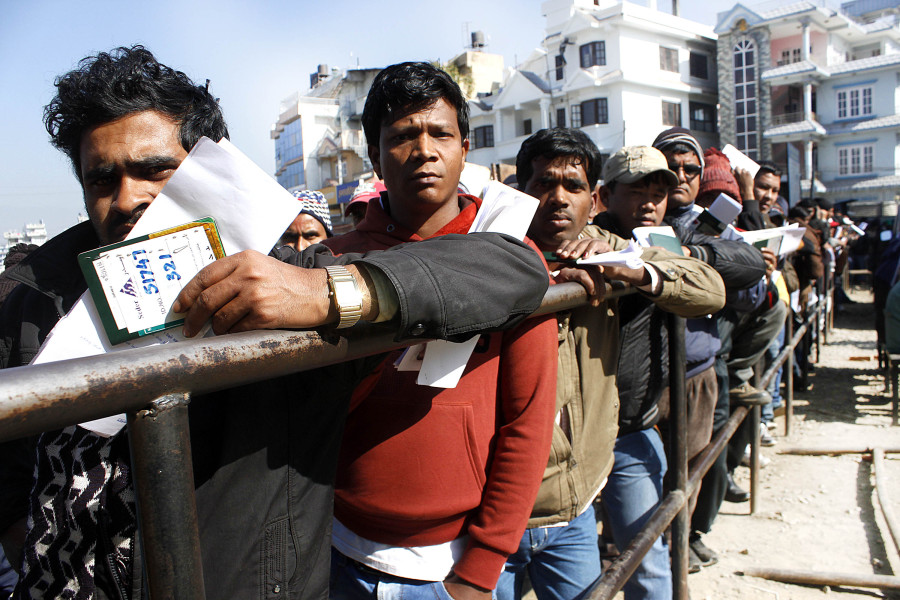Madhesh Province
Easy loans in Province 2 for labour migrants could encourage youths to leave country, experts say
Workers will get up to Rs150,000 at lower interest rates for funding their departures, but experts fear easily available funds will make migration first choice.
Chandan Kumar Mandal
Province 2’s decision to provide subsidised loans for outbound workers has drawn mixed reactions from labour migration experts.
The Province 2 government has made arrangements for issuing up to Rs150,000 in loans to migrant workers at lower interest rates via two commercial banks. As the scheme came into effect, nine aspiring migrant workers received bank loans amidst a ceremony in Janakpur on Thursday.
According to Province 2 Social Development Minister Nawal Kishor Sah, the arrangements were made to provide financial relief for youths who choose to go abroad in search of better opportunities.
“This is not a programme as such but an agreement reached between the Province 2 government and the banks for providing money to youths going abroad,” Sah told the Post. “This will provide much-needed relief to youths who had to borrow money from local lenders at exorbitant rates for funding their departure.”
Youths from eights districts of Province 2 will be eligible for the loan. Prabhu Bank will serve outbound migrant workers from Saptari, Sarlahi, Rautahat, Bara and Parsa districts whereas Nepal SBI Bank will provide loans to youths from Siraha, Dhanusha and Mahottari. At least 10,000 youths will benefit from the scheme, according to Sah.
The interest rates will vary for different categories of people. For marginalised groups like Dalits, the interest rate will be only 5 percent, and for other groups, it will be 11 percent, according to the minister.
“Aspiring migrant workers had to mortgage their lands and other property and those without such assets had to take loans at 36 percent rate,” said Sah. “For accessing loans under this scheme, they do not need to keep anything as collateral.”
The provincial government’s move to fund migration of youths comes as a surprise for experts in the field and has generated a mixed response from them.
According to labour migration researchers, the move to provide subsidised loans will surely benefit youths from Province 2.
Youths from Province 2 were compelled to take loans at higher rates for financing their foreign employment, said Swarna Kumar Jha, a labour migration researcher. “Subsidised loans will help them in getting the required money at cheaper rates.”
Another labour migration researcher Arjun Kharel, who is associated with the Centre for the Study of Labour and Mobility, a think tank, also welcomes the initiative for it will provide loans at cheaper rates.
“During our studies, we have found that people had taken loans at even 60 percent for going abroad,” said Kharel. “At least, these people will get loans at lower rates. This is good from the workers’ welfare point of view.”
However, these experts fear that easily accessible loans might lead to a surge in labour migration from the region. The move is also significant especially because the central government has been talking about slowly controlling labour migration.
Since coming to power, the KP Sharma Oli administration has repeatedly said foreign employment is not a priority and in the next five years, Nepali workers would not be compelled to migrate due to the lack of jobs at home.
“The loan scheme opens the door for those people who could not go on foreign employment because of financial issues,” said Jha, who also coordinates the National Network for Safe Migration, an umbrella body of organisations working in the sector. “This can mean financial opportunities for them but will also see a rise in people migrating abroad.”
These concerns from experts come from the fact that eight districts of Province 2 are among the top labour exporters in the country. Around 24 percent of workers who had received labour permits from the Nepal government between fiscal years 2008/09 and 2016/17 were from Province 2. Out of the top 10 most labour sending districts, five were from Province 2 as of the end of fiscal year 2018-19.
“We cannot completely stop labour migration to foreign countries straight away,” said Sah. “For discouraging the trend, we have to first give them employment and skills. Providing skills and then work is likely to take time. Therefore, we are working on both sides—facilitating labour migration and creating jobs inside the province.”
According to Minister Sah, Province 2 government has also come up with programmes to provide cost-free skills training for youths and give seed money to those who want to start their own enterprise inside the Province. The Social Development Ministry has allocated Rs80 million for providing seed money. Besides, the provincial government also launched heavy equipment training this week and has plans of training nearly 5,000 youths for three months.
“We are making sure that unemployed people get work here as well. Those who still want to go abroad should receive training so that they do not suffer abroad,” said Sah.
However, migration experts also reckon that providing a loan can not only see a surge in the number of individuals from Province 2 going abroad but it can also alter the whole trend of labour migration.
“There are still people from Province 2 who go to India for work whereas others migrate to other parts of the country,” said Kharel. “With the funds available, even seasonal migrants will opt for long-term migration to Gulf countries and Malaysia.”




 24.12°C Kathmandu
24.12°C Kathmandu














